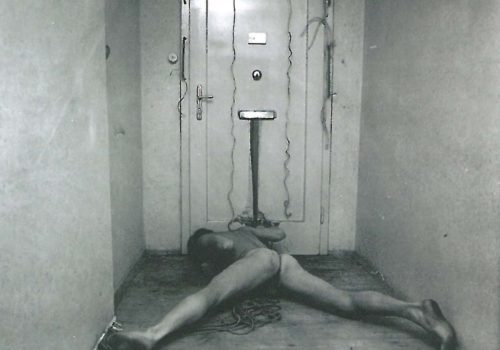Konzett Gallery’s (Vienna) show concentrates on two of the main protagonists of Vienna Actionism, Günter Brus and Otto Muehl. Günter Brus, who nowadays calls himself a ‘poet of the picture’, became part of the Austrian art history by means of two prominent actionist performances: His body painted white and parted in two halves by a black line, and promenading downtown Vienna in 1965. Three years later he was entitled Austria’s most disliked citizen he daggled the lecturer‘s desk in the New Institute Building of the Vienna University in the context of his “Bodyanalysis”. In the early 1960’s, the consistent expansion of his early pictorial work leads Otto Muehl (born 1925 in Grodnau) from the creation of material-pictures to junk sculptures in the transgression of genres. Using the method of destruction or rather by embedding common materials, Muehl, one of the main protagonists of Vienna Actionism, abandoned the work with conventional panel painting. The human body itself became an element of the performance equal to any other material used. Until the end of 1966 Muehl carried out his so-called “Materialaktionen (material-actions)“, usually with the assistance of a female model and with interruptions of their course in front of invited guests – including among others futurologist Robert Jungk, psychiatrist and psychoanalyst Alexander Caruso, painter and graphic designer Kurt Moldovan, Raoul Schindler, head of the psychiatric hospital of Vienna. Among other rare photographic works, we will present Muehl’s photo-edition “Oh Sensibility“, 1970.
Westlicht Gallery (Vienna) presenting Viennese Actionist Photography. Viennese Actionism can be seen as Austria’s most important contribution to the post avant-garde art movements of the 1960s. Günter Brus, Hermann Nitsch, Otto Muehl and Rudolf Schwarzkogler were making the body and the performance central themes of their artistic discourse. These actionist artists contributed greatly to the development of performance art, ranging from Happening, over Body-Language-Art to installations. Photography plays a very important role in the Actionist oeuvre, as it was a means of documentation for performances and happenings. Only through photographs can we now trace the actionist works between 1963 and 1971. At this point it is important to point out that photography was not only used for documentation, it was seen as a new, expressive and meaningful pictorial language, as opposed to painting. Especially in the years from 1964 to 1966 that show a climax of this artistic process, many very suggestive images were produced at this time. Film and the camera were not only a way of freeing oneself of the painted picture, it was also a performance-friendly medium and an opportunity to reflect the language developed during the artistic process. The capture of performances on film utilizes the precise and clear language of the photographic image. The structure, the study of the image, the still life, and the single shot gain importance through this process.
















